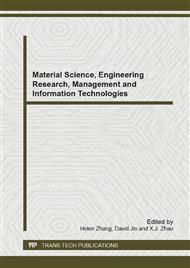[1]
Xu WeiChang. The Current Situation and Prospect of Wastewater-treatment in Dyestuff Industry. Dyestuff Industry, Vol. 39-6 (2002), p.35.
Google Scholar
[2]
LiYin, XiDanli. Analyses of dye and related compounds during biodegradation. Chinese Journal ofEnvironmentalEngineering, Vol. 1-8 (2007), p.57.
Google Scholar
[3]
Shao Qing, Yang Xinyu. Research on the application of modified clay to the treatment of wastewater from dyestuff technology. Industrial Water Treatment, Vol. 26-10 (2006),P. 84.
Google Scholar
[4]
Wu Jiaqiang Ma Hongrui Wei Junfui, etl. Study on Modification andAdsorption of Natural Montmorillonite and Graphite. Non-Metallic Mines, Vol. 31-6 (2008).P. 61.
Google Scholar
[5]
Boyd S A,Lee Jiunn-Fwu,Mortland M M. Attenuating organic contaminant mobility by soil modification. Nature, Vol. 333-26(1988),P. 345.
DOI: 10.1038/333345a0
Google Scholar
[6]
Jaynes W F,Boyd S A. Clay mineral type and organic compound sorption by hexadecyltrimethylammonium-exchanged clays. Soil Sci Soc Am J, Vol. 55(1991),P. 43.
DOI: 10.2136/sssaj1991.03615995005500010007x
Google Scholar
[7]
Boyd S A, Mortland M M, Chou C T. Sorption characteristics of organic compounds on hexadecyltrimethylammonium-smectite. Soil Sci Soc Am J, Vol. 42(1988),P. 652.
DOI: 10.2136/sssaj1988.03615995005200030010x
Google Scholar
[8]
LiShu, SunYabing, Feng, Jingwei, etl. Chinese Journal of Environmental Engineering, Vol. 1-7 (2007),P. 47.
Google Scholar
[9]
Zhu Lizhong, Chen Baoliang, Luo Yu. The properties and mechanisms for organobentonites to sorb polycyclic aromatic hydrocarbons in water. Acta Scientian Circumstantian, Vol. 20-1 (2000), p.21.
Google Scholar
[10]
hu Lizhong, Wang Qing, Chen Baoliang. Sorption of Aniline and Phenol to Anion-cation Organobentonites from Water. Environmental Science, Vol. 21-4 (2000), p.42.
Google Scholar
[11]
Zhu Lizhong, Chen Baoliang, Ge Yuanshu, etl. Sorption Properties of p-nitrophenol to anion-cation organobentonitea from water. Environmental Chemistry, Vol. 19-5(2000), p.419.
Google Scholar
[12]
Liu Na, Chen Changshu, Fu Yunna. Adsorption of phenanthrene on organic clays. Environmental Pollution and Control, Vol. 28-11 (2006), p.811.
Google Scholar


